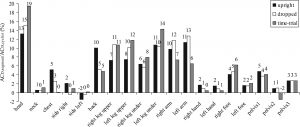Many elite cyclists use wind tunnels to improve their aerodynamic performance. The wind tunnel gives information on the total drag in different positions. They can, therefore, try different positions to see which gives the lowest drag. This is something of a trial and error process. In this study Computational Fluid Dynamics (CFD) is used to simulate airflow and understand what is causing drag. This may allow design for better aerodynamic performance. The drag caused by each body part is calculated and the heat transfer coefficient is also calculated.
The analysis was carried out for three positions, the upright position, riding on the dropped handlebars and in a time trial position. For each position, a laser scanner was used to measure the cyclist, the bicycle was not modeled. Validation of the simulation model was carried out by comparison with full-scale wind tunnel experiments in which surface pressure was measured at 115 positions on the cyclist’s body.

19 body sections were considered. These were the head, neck, each arm, each side of the body, the chest, the back, 3 sections of the pelvis, the upper and lower section of each leg and each hand and foot. The head was the largest single contributor to drag in all positions.

Abstract:
This study aims at investigating drag and convective heat transfer for cyclists at a high spatial resolution. Such an increased spatial resolution, when combined with flow-field data, can increase insight in drag reduction mechanisms and in the thermo-physiological response of cyclists related to heat stress and hygrothermal performance of clothing. Computational fluid dynamics (steady Reynolds-averaged Navier-Stokes) is used to evaluate the drag and convective heat transfer of 19 body segments of a cyclist for three different cyclist positions. The influence of wind speed on the drag is analysed, indicating a pronounced Reynolds number dependency on the drag, where more streamlined positions show a dependency up to higher Reynolds numbers. The drag and convective heat transfer coefficient (CHTC) of the body segments and the entire cyclist are compared for all positions at racing speeds, showing high drag values for the head, legs and arms and high CHTCs for the legs, arms, hands and feet. The drag areas of individual body segments differ markedly for different cyclist positions whereas the convective heat losses of the body segments are found to be less sensitive to the position. CHTC-wind speed correlations are derived, in which the power-law exponent does not differ significantly for the individual body segments for all positions, where an average value of 0.84 is found. Similar CFD studies can be performed to assess drag and CHTCs at a higher spatial resolution for applications in other sport disciplines, bicycle equipment design or to assess convective moisture transfer.
Reference:
“Computational fluid dynamics analysis of drag and convective heat transfer of individual body segments for different cyclist positions”
Thijs Defraeye Bert Blocken Erwin Koninckx Peter Hespel Jan Carmeliet
Journal of biomechanics. , 2011, Vol.44(9), p.1695-1701
Let us know what you think